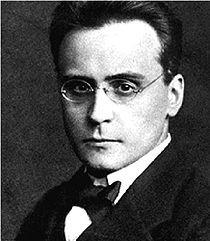We are always welcoming new composers to our Henle catalogue. As our readers certainly know, we publish only music that is copyright-free; you could say that the composer must have already been dead for 70 years in order to make it into our repertoire. Such major occurrences were, for instance, the first Henle editions of Sergei Rachmaninoff’s works in 2014, or just recently, the Allegro barbaro by Béla Bartók (see the blog posting on this by my colleague Annette Oppermann).
But in 2016 it was not only Bartók who became “free”. Anton Webern died in 1945, the same year as his Hungarian colleague, and so he can be accommodated this year in the “blue” Henle catalogue. Webern is undoubtedly one of the most important figures in the music of the 20th century. Although his body of works is slim, and his works are of almost legendary brevity, Webern’s influence on the development of 20th-century music was enormous. His Variations op. 27, edited by Ullrich Scheideler, is a crucial work to appear in the G. Henle publishing house.
Ullrich Scheideler consulted not only the first edition, published in 1937, and the fair-copy autographs and manuscript copies preserved in The Pierpont Morgan Library, New York, but also the sketch material from the Webern collection in the Paul Sacher Stiftung, Basel, as well as a galley proof for the first edition presently in the Österreichische Nationalbibliothek [Austrian National Library], Vienna. This fund of sources documents the most important stages of the work from sketch to first edition, and Scheideler succeeds in unrolling the Variations’ detailed genesis against this backdrop. So, our edition is the first Urtext edition to classify the music text historically and genetically and to provide a detailed critical source apparatus!
As an “extra” Ullrich Scheideler has even called in a further source tier, copies of the first print that were used when Webern studied his variations with several pianists. Two of these copies – from Peter Stadlen and Else Cross – are extant; they contain Webern’s entries on agogics and interpretation, which though highly revealing are probably tailored to each student individually. As they aren’t part of the generally valid shape of the work, they are therefore summarily documented in the preface and don’t enter into our edition per se.
Webern’s music is known for its strict organisation, and so it isn’t any wonder that the sources reflect these structural and systematic intentions. Among the three New York manuscript sources, accessible meanwhile online, I’d like to single out here the autograph engraver’s model. The notation is of astounding precision and clarity. You are right if you suspect that such a manuscript hardly raises any questions. Add to that the first edition scrupulously corrected by Webern, and we get a music text that leaves virtually nothing to be desired. A clear matter, editorially, or so we might think. And yet in preparing the edition we came across a contradiction not quite fitting into our picture of Webern’s precision.
On the final music page of the first edition Webern gives “10 min.” as the work’s total duration. This indication was apparently added shortly before publication, for it is lacking in all other sources, including the above-mentioned galley proof. In the print the individual movements do not have any duration information, although several of the manuscript sources give “3½ min.” for movement I, and “1 min.” for movement II. There can be little doubt that this duration information goes back to the composer himself.
Astonishing, but true: All three duration indications are obviously wrong! Based on the surely reliable metronome markings, movement I lasts from 1½ to 2 minutes, movement II, about 30 seconds. The whole work takes barely 6 minutes.
Wrong information for overall duration can also be found in other Webern works (Hans Moldenhauer also mentions opp. 5 and 10 in his fundamental work, Anton von Webern: Chronik seines Lebens und Werke, Zurich, etc., 1980, p. 294). The reason for this discrepancy remains a mystery. What’s your idea here?
Incidentally, the Peter Stadlen mentioned above, certainly a guarantor of an authentic performance, played Webern’s Variations in 5 minutes, 48 seconds, at the Darmstadt Summer Course for New Music in 1948; Glenn Gould needed only the record-breaking 5 minutes, 12 seconds, in his recording.


excellent article and competent
Teodor Caciora